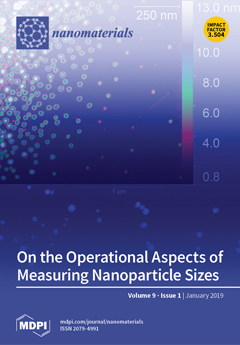Development of simple, convenient, and sensitive assay methods for pyrophosphatase (PPase) activity is of importance, for disease diagnosis and drug discovery. Herein, a simple, rapid, label-free, and sensitive fluorescence sensor for PPase activity assay is developed, using Cu
2+ doping-induced quantum dot (QD)
[...] Read more.
Development of simple, convenient, and sensitive assay methods for pyrophosphatase (PPase) activity is of importance, for disease diagnosis and drug discovery. Herein, a simple, rapid, label-free, and sensitive fluorescence sensor for PPase activity assay is developed, using Cu
2+ doping-induced quantum dot (QD) photoluminescence as a signal reporter. The Cu
2+ doping of ZnSe QD can induce a dopant-dependent emission response, which will be inhibited after the premixing of Cu
2+ with pyrophosphate (PPi), to form a Cu
2+-PPi complex. Then, the hydrolysis of PPi into phosphate (Pi), specifically catalyzed by PPase, liberates the free Cu
2+ to regain the QD doping for the fluorescence response, which is highly dependent on the PPase activity. The PPase can be sensitively and selectively assayed, with a detection limit of 0.1 mU/mL. The developed sensing strategy can be also employed for the PPase inhibitor screening. Thus, the current QD doping-based sensing strategy offers an efficient and promising avenue for Cu
2+, PPi, or PPase-related target analysis, and might hold great potential for the further applications in the clinical disease diagnosis.
Full article






